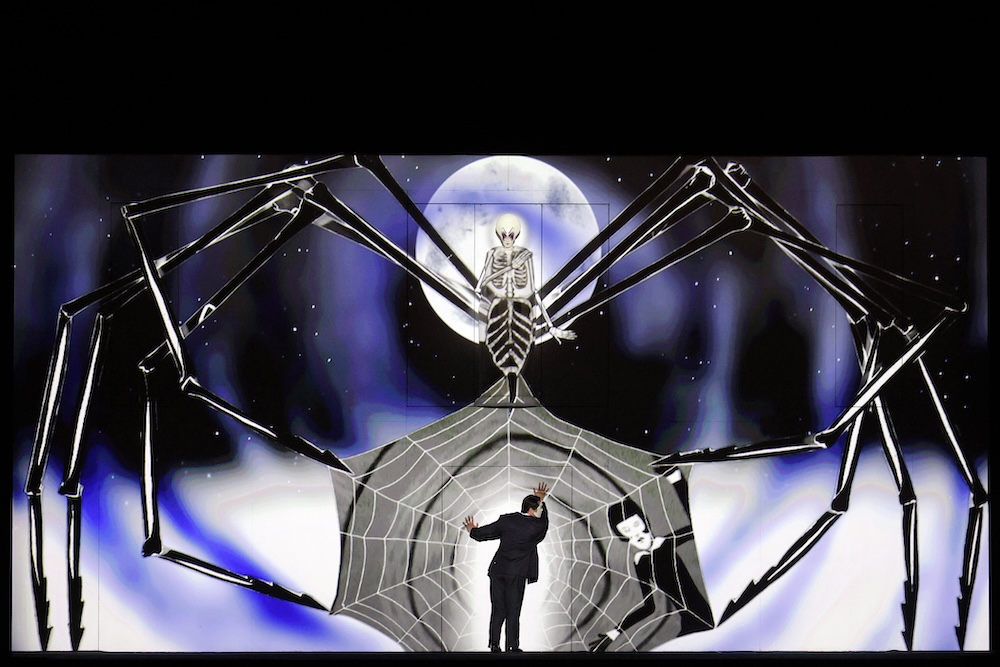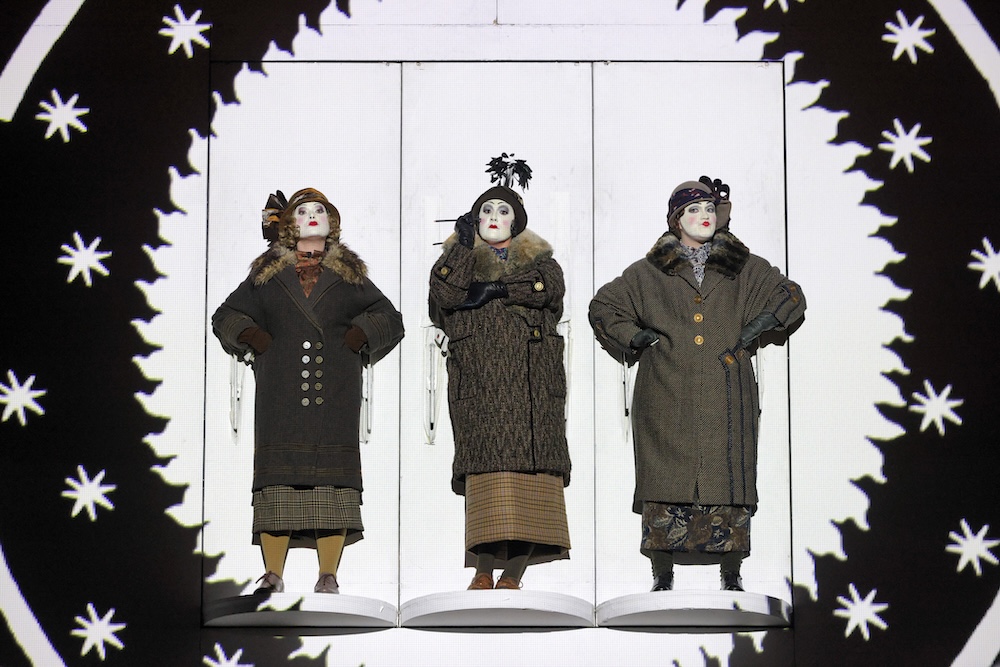It was a hot ticket in Berlin back in 2012, it has since played in L.A. (2013), Chicago (2021), Des Moines (2022), and around the world in many editions throughout the past decade. It’s Barrie Kosky’s The Magic Flute now on the stage of the War Memorial Opera House in San Francisco!
We all know Mozart’s Flute pretty well these days so we can easily welcome a riff on this all too familiar material. Actually the production was a collaboration for Berlin’s Komische Oper by the Australian born, Teutonic formed Barrie Kosky and Susanna Andrade of the British theater company named “1927” (the year of the film Jazzman, a monument of early filmic art that sits on the cusp of silence becoming sound in film).
Though the production does not have the shock value of the huge caricatured Jew (hooked nose and evil grin) that Mr. Kosky (of Jewish descent) inflicted on a Bayreuth Meistersinger, nor the off-the-wall, weird sexual takes or outrageous nudity that often embellish Kosky productions, it does have the sheer audacity to butcher this holiest of all holy operas.
And to do so with unrelenting visual quotes from the silent film era with copious, added unrelenting animation. Never mind that it is charming — at least in intention. Suffice to say that the Queen of the Night is an animated spider, Papageno is Charlie Chaplin and the magic flute is a dragon fly. If nothing else the Kosky/Andrade production brilliantly rekindles the legendary Berlin/Hollywood film connection.

Audiences worldwide, and now San Francisco audiences too, react with delight, chuckles, ooh’s and ah’s, and sometimes even the laughs that silent films may elicit. Though however charmed audiences may be they are left bereft of the magnificence of Mozart’s magical singspiel.
The Kosky version eliminates all dialogue and much orchestral accompanied recitative, substituting mimed action with projected ye olde titles (descriptions or explanations) to the accompaniment of highly melodramatic moments from a few very highly amplified Mozart fortepiano pieces. The result is a disjointed musical flow, the opera no longer about words but instead about images, be they animated film cartoons or silent film quotations with simulated silent film piano sounds.
Mozartian magic could perhaps have been discovered in this imagistic storytelling had the singers been a larger component of the storytelling. The stage was simply a simulated, huge movie screen that sat immediately and elevated on the War Memorial stage. Most of the singing emanated from cut out openings high within the screen’s structure. The voices often seemed far away, and sometimes superfluous to the orgy of projected images. Nonetheless here in San Francisco the famed arias and songs were all delivered with measured, studied artistry.
The singers had limited contact with San Francisco Opera music director Eun Sun Kim situated way down below. This served to isolate the pit from the stage, which often happens with this maestro when she either does not resonate with the singers or she loses contact. The un-staged overture was offered in stately, measured symphonic terms. The lack of clear plot flow however suppressed the symphonic terms that normally suffuse the second act.
On the other hand there was an astonishing coordination of the pit and voices with the flow of animation, un-nerving when it was not boring.
The music seldom took hold, in fact there were only two scenes where music enveloped the auditorium and these were the famed second act choruses, top-hatted singers in formal dress standing on the stage level of the imagined movie palace in front of its bright red curtain. San Francisco Opera’s maestra achieved real musical magic in these moments (though even here there was animated embellishment projected on a scrim, distancing us from the stage).
New Zealand tenor Amitai Pati gamely went through the paces of integrating himself into the animation, deftly dodging all illusionary obstacles thrown in his path. Mr. Pati is a polished performer, of refined voice. With the truly elegant phrasing of his arias he managed to elevate this Tamino to plausible candidacy for redemption. Austrian soprano Christina Gansch was an understated Pamina, vocally mismatched to the purer colors one wishes for this heroine’s voice and presence.
The star of the show was German baritone Lauri Vasar as Charlie Chaplin sans moustache aka Papageno. Mr. Vasar’s postures were pure Chaplin, vocally he was much more richly endowed than the usual Papageno. He was a warm, abstractly human silent film character (who incongruously sang beautifully) aided in no small way by the complete absence of the usual Schikaneder (the Magic Flute’s playwright) imposed schtick.
The face and voice of Polish soprano Anna Siminska was the Queen of the Night — the rest of Mme. Siminska was hidden behind the movie screen, her on screen character was a gigantic spider, her vocal presence was soft and pretty, hardly the impassioned, poisonous fury to match the measured authority of Sarastro, her enlightened counterpart. Sarastro was sung by Korean bass Kwangchul Youn, a role for which he is not suited. The Speaker was well projected by Korean bass Jongwon Han, the evil Monostatos, sung by Chinese tenor Zhengyi Bai, was lost in the fray of animation, as was the Papagena sung by Adler Fellow Arianna Rodriguez.

On the other hand, the Queen of the Night’s ladies-in-waiting were perfection itself, Soprano Olivia Smith, mezzo soprano Ashley Dixon and mezzo soprano Maire Therese Carmack made bright, lively sounds in impeccable ensemble. As well, the armored guards, tenor Thomas Kinch and bass-baritone James McCarthy made welcomed, forceful lively sounds as they descended in the basket of an animated balloon.
The three spirits were well and very carefully sung by Niko Min, Solah Malik and Jacob A. Rainow who seemed appropriately terrorized by the maestra.
This most recent edition of the Kosky/Andrade production was more colorful and more animated than the earlier version I saw in Los Angeles in 2013, obviously the victim of its continued travels worldwide.
Michael Milenski